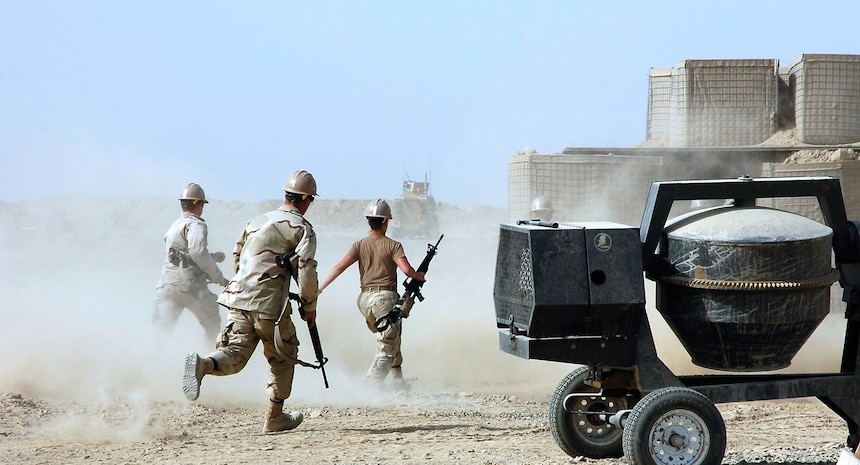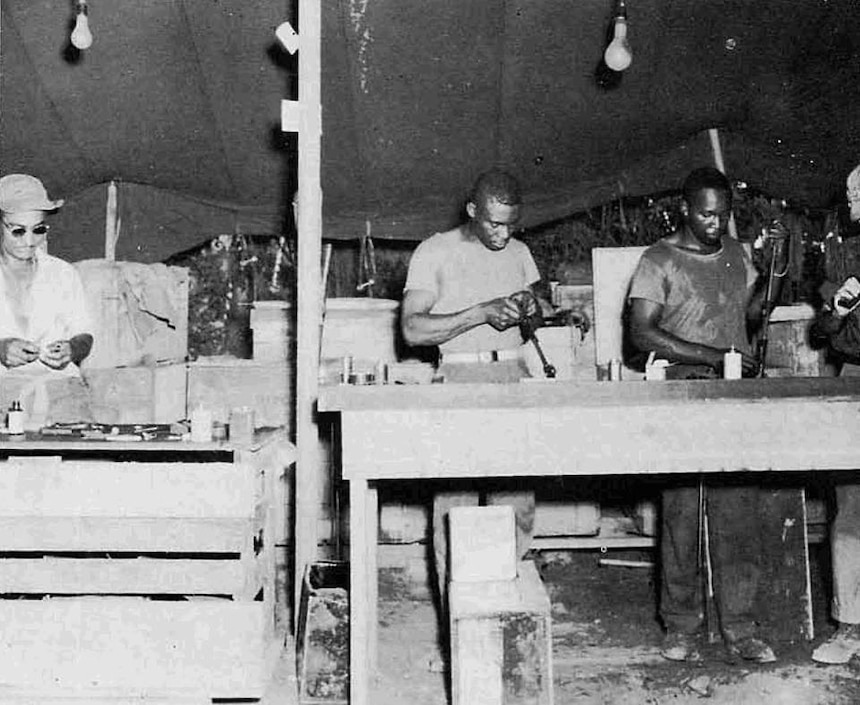Consolidated by U.S. Navy Seabee Museum, Naval History and Heritage Command
October 21
1943: 138th NCB commissioned at NCTC Camp Peary, Magruder, Virginia.
October 22
1942: 35th NCB commissioned at Camp Endicott, Davisville, Rhode Island.
1967: Main body of NMCB 40 departed Davisville, Rhode Island for reassignment to the 30th NCR for duty at Chu Lai, RVN; NMCB 128 s main body deployed from CBC Gulfport, Mississippi to Camp Faulkner, Da Nang, East RVN in eight C-141 aircraft.
1968: NMCB 4 main body departed Camp Haines for Da Nang, RVN and from Da Nang to CBC, Port Hueneme, California.

October 23
1943: 130th Naval Construction Battalion (NCB) commissioned at Naval Construction Training Center (NCTC) Camp Endicott, Davisville, Rhode Island.
1944: Advance Base Depot Receiving Barracks (Camp Thomas), Davisville was disestablished and facilities and functions of the barracks were transferred to NCTC Davisville.
1947: 109th NCB inactivated on Guam.
1966: Main body of Naval Mobile Construction Battalion (NMCB) 58 departed Davisville, Rhode Island for Da Nang, Republic of Vietnam (RVN).
1967: The first Civil Engineer Corps (CEC) officer to be killed in Vietnam was Lt. Joseph J. Rhodes, a member of Mobile Construction Battalion (MCB) 121. Rhodes was riding in a jeep that struck a land mine and he died from multiple shrapnel wounds. Two other occupants of the jeep, Chief Steelworker Gordon J. Dibble and Builder (Concrete) 3rd Class Jon R. Morbay, were also killed. A Seabee camp at Quang Tri, RVN was later dedicated in Rhodes memory. A plaque bearing the inscription, Camp Rhodes Dedicated in Honor of Lt Joseph John Rhodes, Killed in Action October 23, 1967 was unveiled by Rear Admiral A.C. Husband, then Chief of Civil Engineers.
1967: Main body of NMCB 133 departed RVN and returned to Construction Battalion Center (CBC), Gulfport, Mississippi; an NMCB 11 advance party of two officers, 27 enlisted personnel, and 1 dog (Seabee Team 1108 s mascot Colonel ) departed Dong Ha, RVN for return to the continental U. S. (CONUS).
1968: Cmdr. D.A. Bartley, commanding officer of NMCB 10, relieved Cmdr. R.M. Fluss, commanding officer of NMCB 4, as commanding officer of Camp Haines, RVN.
1969: Seabee Teams 0915 and 0916 were transferred to NMCB 10.
2009: Rear Adm. Richard E. Cellon, CEC, USN was relieved by Rear Adm. Mark A. Handley, CEC, USN as the commander, First Naval Construction Division (NCD), Joint Expeditionary Base Little Creek, Virginia.
October 24

1944: Tank mounted flame throwers became a productive weapon for routing Japanese soldiers out of caves and pillboxes during the Second World War. A composite group was set up to assist the Army s Chemical Warfare personnel in developing this weapon. Included in the group were an officer and 25 Seabees from the 117th NCB. After several demonstrations, the flame throwing tank proved to be generally satisfactory except for one technical detail, which the tankmen said was a distinct disadvantage. The Seabees set to work on a design for a functional modification of the weapon. Not only did the Seabee design eliminate the objectionable feature of the prior models, but it greatly reduced the number of moving parts. At its first demonstration on October 24, 1944, the new weapon was given enthusiastic approval by tankmen and chemical warfare officers. In addition to building these flame thrower tanks, Seabees also instructed tankmen how to operate them. The Seabee instructors assisted in making experts out of Army and Marine tankmen before the tanks went into action in such places at Iwo Jima, Okinawa, and Peleliu.
1944: 9th Naval Construction Brigade commissioned; 41st Naval Construction Regiment (NCR) commissioned.
1945: 36th NCR inactivated.
1967: Cmdr. D.W. Wittschiebe, CEC, USN, commanding officer of NMCB 128, relieved Cmdr. E.H. Marsh, CEC, USN, commanding officer of NMCB 133, at camp Faulkner, Da Nang East, RVN; NMCB 128 main body arrived in Da Nang, RVN; NMCB 71 main body of 20 officers and 782 Seabees departed Chu Lai, RVN for Davisville, Rhode Island on nine C-141 aircraft; NMCB 40 main body arrived in Chu Lai, RVN.
October 25
1945: 6th NCB inactivated. 11th Special NCB inactivated at Okinawa.
1963: U.S. Naval Ship Missile Systems Engineering Station officially dedicated at CBC Port Hueneme, California.
1967: Main body of NMCB 71 arrived at Davisville, Rhode Island from Chu Lai, RVN.
October 26
1966: Capt. Greer A. Busbee, Jr., relieved Capt. Spencer R. Smith as commander, Atlantic Fleet Naval Construction Battalions; NMCB 1 main body left Da Nang, RVN for Davisville, Rhode Island by C-141 aircraft via Japan and Alaska.
2012: Rear Adm. Katherine (Kate) L. Gregory assumed duties as commander, Naval Facilities Engineering Command (NAVFAC) and chief of Civil Engineers, the first woman in Navy history to hold either position.
October 27
1943: During the invasion of Mono Island in the Treasury group of the Solomon Islands, a party of Seabees from NCB 87 landed within an hour after the assault began. The party, headed by Lt. Charles E. Turnbull, CEC, U.S. Naval Reserve, also included Machinist Mate 1st Class (Construction Battalion Equipment Operator) Aurelio Tassone and his 20-ton bulldozer. The assaulted troops were being held down by fierce Japanese gunfire from cannon and machine guns hidden in a strongly built pillbox. After some discussion, it was decided that Tassone would see what his dozer could do to it. Raising his blade for protection, and supported by Turnbull, who was armed with a carbine, Tassone rushed the pillbox. When he reached the obstruction, he exerted down pressure on the blade and tore into the barricade, covering the defenders with logs and tons of earth. None of the enemy troops emerged alive. Both Tassone and Turnbull were awarded the Silver Star Medal for their bravery.
1970: Seabee Team 0319 deployed to Xuan Loc, RVN, via government aircraft.
